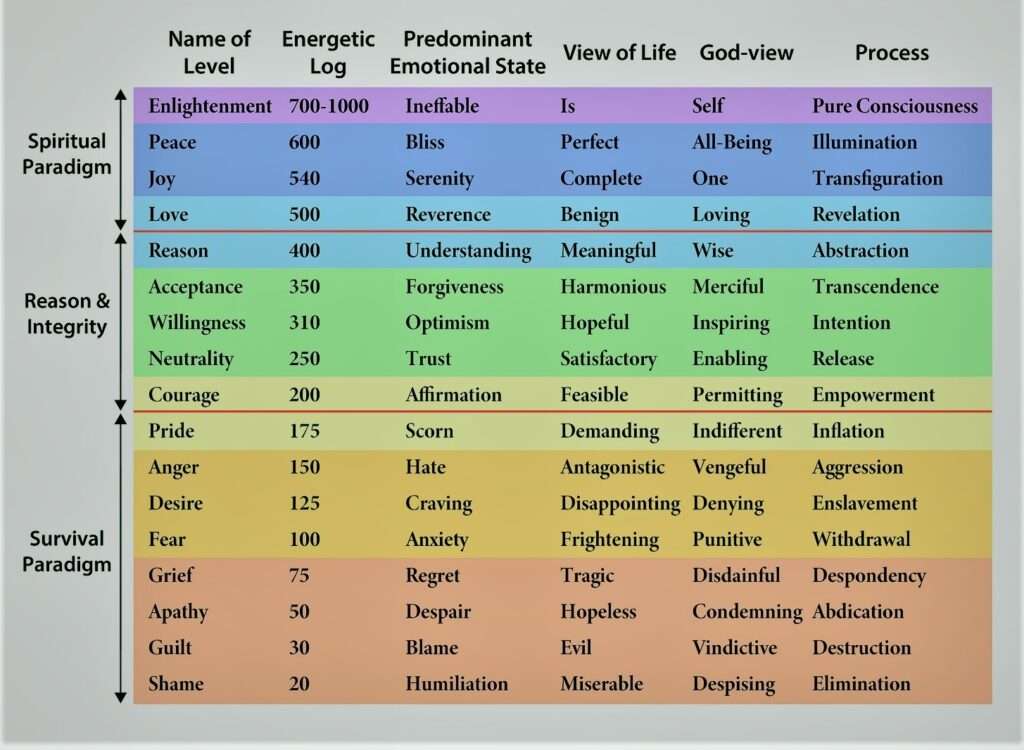As human beings, we are constantly searching for ways to improve our lives. We want to be happier, healthier, and more fulfilled. One way to achieve this is by understanding the scale of consciousness and how it can impact our lives. In this article, we will explore the different levels of consciousness and how they can improve your life.
Understanding the Scale of Consciousness
The scale of consciousness is a model developed by Dr. David Hawkins, a psychiatrist and researcher. According to this model, everything in the universe, including people, emotions, and experiences, can be ranked on a scale from 0 to 1000. The higher the number, the more positive and beneficial the item or experience is to our well-being.
The scale of consciousness is divided into three sections:
Lower Levels of Consciousness
The first section of the scale of consciousness includes everything below the 200 level. This includes emotions such as shame, guilt, apathy, and fear. People who are in this section tend to have a negative view of the world and see themselves as victims. They may struggle with addiction, depression, and other mental health issues.
Middle Levels of Consciousness
The second section of the scale of consciousness includes everything between 200 and 500. This includes emotions such as courage, willingness, forgiveness, and love. People who are in this section tend to be more positive and optimistic. They are open to personal growth and may have a spiritual practice.
Higher Levels of Consciousness
The third section of the scale of consciousness includes everything above the 500 level. This includes emotions such as peace, joy, and enlightenment. People who are in this section tend to have a deep sense of inner peace and fulfillment. They may have a strong sense of purpose and feel connected to something larger than themselves.

How the Scale of Consciousness Works
The scale of consciousness works on the principle of resonance. This means that we attract experiences and people that match our current level of consciousness. For example, if we are in the lower levels of consciousness, we may attract negative people and experiences that reinforce our negative beliefs about ourselves and the world.
Conversely, if we are in the higher levels of consciousness, we may attract positive people and experiences that support our growth and well-being. By understanding the scale of consciousness, we can become more aware of our current level of awareness and take steps to raise our vibration.
Dr. Hawkins developed the Scale of Consciousness through a combination of kinesiology and the logarithmic scale.
Kinesiology and Muscle Testing
Kinesiology, the study of body movement, plays a significant role in determining the level of consciousness associated with various emotions. Muscle testing, a technique used in applied kinesiology, measures the body’s response to specific questions or stimuli. Dr. Hawkins used muscle testing to calibrate the levels of consciousness.
Understanding the Logarithmic Scale
The Scale of Consciousness uses a logarithmic scale, which means that each increment represents a tenfold increase in consciousness. For example, a person at the level of 300 (willingness) has ten times the consciousness of someone at the level of 200 (courage).
Practical Applications of the Scale
The Scale of Consciousness has numerous practical applications for personal growth, assessing group consciousness, and healing:
Personal Growth and Development
By understanding the scale and identifying their level of consciousness, individuals can focus on personal growth and development. For example, someone at the level of fear (100) can work on cultivating courage (200) and eventually reach higher levels like love (500) or peace (600).
Assessing Group and Global Consciousness
The scale can also be used to assess the collective consciousness of groups or even entire nations. This information can be beneficial for understanding societal dynamics and predicting future trends or conflicts.
Healing and Recovery
The Scale of Consciousness can serve as a valuable tool for those involved in healing and recovery, such as therapists, coaches, or spiritual guides. By understanding the levels of consciousness associated with various emotions, they can better support clients in overcoming challenges and reaching higher levels of awareness and well-being.
Conclusion
The Scale of Consciousness, developed by Dr. David R. Hawkins, is a fascinating tool for understanding human consciousness and its various levels. While it has practical applications for personal growth, assessing group consciousness, and healing, it’s essential to recognize its limitations and potential pitfalls. By using the scale as a guide, rather than an absolute measure, individuals can embark on a journey of self-discovery and growth.

